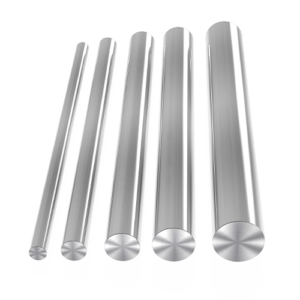Introduction

Stainless steel bars are ubiquitous in various industries, offering exceptional strength, durability, and corrosion resistance. From towering skyscrapers to intricate art pieces, stainless steel bars play a vital role in modern construction and crafting. This blog explores the diverse applications and versatility of stainless steel bars, showcasing their significance across different sectors.
Properties of Stainless Steel Bar
Stainless steel bars possess a unique set of properties that make them highly desirable in numerous applications.
- Corrosion Resistance: Stainless steel bars exhibit excellent resistance to corrosion, making them ideal for outdoor and marine applications. This property ensures longevity and reduces maintenance costs for structures exposed to harsh environmental conditions.
- Strength: With high tensile strength, stainless steel bars offer structural integrity and reliability in demanding environments. They can withstand heavy loads and extreme temperatures, making them suitable for use in critical applications such as bridges and high-rise buildings.
- Durability: Stainless steel bars are known for their durability, ensuring longevity and minimal maintenance requirements. They are resistant to wear, abrasion, and deformation, maintaining their structural integrity over extended periods.
- Versatility: Available in various shapes and sizes, stainless steel bars can be customized to meet specific project requirements. Whether it’s a simple reinforcement rod or a complex architectural feature, stainless steel bars offer versatility in design and functionality.
Applications in Construction
Stainless steel bars are indispensable in the construction industry, where structural integrity and longevity are paramount.
- Reinforcement: Stainless steel bars are commonly used as reinforcement in concrete structures, providing added strength and durability. They enhance the load-bearing capacity of concrete elements and minimize the risk of structural failure.
- Architectural Detailing: Stainless steel bars are utilized for architectural detailing, offering aesthetic appeal and structural support in building facades and interior designs. Their sleek and modern appearance enhances the visual appeal of architectural elements, such as handrails, balustrades, and cladding systems.
- Infrastructure: From bridges to tunnels, stainless steel bars play a vital role in enhancing the resilience and longevity of infrastructure projects. They are used in structural components such as beams, columns, and tension rods, ensuring the stability and safety of transportation and utility systems.
Applications in Crafting
Beyond construction, stainless steel bars serve as versatile materials in crafting and artistic endeavors.
- Sculpture: Stainless steel bars are sculpted into intricate forms, allowing artists to create captivating sculptures with enduring beauty. The malleability of stainless steel enables artists to explore various shapes and textures, from abstract forms to lifelike representations.
- Jewelry Making: Stainless steel bars are increasingly popular in jewelry making due to their hypoallergenic properties and lustrous finish. They are used to create durable and stylish jewelry pieces, ranging from minimalist designs to bold statement pieces. Stainless steel jewelry is resistant to tarnishing and corrosion, making it an ideal choice for everyday wear.
- Metalworking: Craftsmen utilize stainless steel bars for metalworking projects, such as furniture making, decorative pieces, and custom fabrication. Stainless steel’s versatility allows for intricate detailing and precision machining, resulting in high-quality finished products. From functional furniture to ornamental accents, stainless steel bars add a touch of sophistication to interior and exterior spaces.
Environmental Sustainability
Stainless steel bars contribute to environmental sustainability in several ways.
- Recyclability: Stainless steel is highly recyclable, with the majority of stainless steel products being made from recycled material. This reduces the demand for virgin resources and minimizes the environmental impact of stainless steel production.
- Longevity: The durability and corrosion resistance of stainless steel bars result in longer service life, reducing the need for frequent replacements and minimizing waste. This extends the lifespan of infrastructure and consumer goods, conserving resources and reducing landfill waste.
- Energy Efficiency: Stainless steel production processes have become more energy-efficient over time, further reducing the environmental footprint of stainless steel products. Advances in technology and process optimization have led to significant reductions in energy consumption and greenhouse gas emissions in stainless steel manufacturing.
Here’s a table showcasing the different grades of stainless steel commonly used in construction and crafting:

| Grade | Description |
|---|---|
| 304 Stainless Steel | – Widely used for its excellent corrosion resistance and formability. <br> – Suitable for a variety of applications, including architectural detailing, kitchen equipment, and jewelry making. |
| 316 Stainless Steel | – Offers superior corrosion resistance, particularly in marine environments and chemical processing. <br> – Commonly used in coastal construction, marine hardware, and medical implants. |
| 430 Stainless Steel | – Known for its magnetic properties and high corrosion resistance in mildly corrosive environments. <br> – Used in applications such as automotive trim, appliances, and decorative components. |
| 410 Stainless Steel | – Features high strength and hardness, making it suitable for applications requiring wear resistance and durability. <br> – Often used in industrial equipment, tooling, and firearm components. |
Conclusion
Stainless steel bars are versatile materials that find widespread applications in construction, crafting, and beyond. With their exceptional properties and environmental sustainability, stainless steel bars continue to be indispensable in various industries. Whether reinforcing concrete structures or crafting intricate artworks, stainless steel bars epitomize strength, durability, and timeless elegance.
FAQ
Q:Are stainless steel bars suitable for outdoor use?
A:Yes, stainless steel bars exhibit excellent corrosion resistance, making them ideal for outdoor applications.
Q:Can stainless steel bars be welded?
A:Yes, stainless steel bars can be welded using appropriate welding techniques and equipment.
Q:Are stainless steel bars recyclable?
A:Absolutely, stainless steel is highly recyclable, contributing to environmental sustainability.
Q:What shapes and sizes are available for stainless steel bars?
A:Stainless steel bars come in various shapes (round, square, hexagonal) and sizes, catering to diverse project requirements.
Q:Are there any limitations to using stainless steel bars?
A:While stainless steel bars offer numerous advantages, they may be costlier compared to other materials in some applications. Additionally, special care is required during fabrication to avoid contamination and maintain the material’s integrity.
